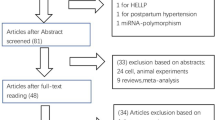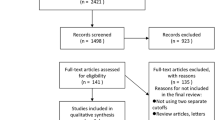Abstract
Preeclampsia (PE) is one of the main causes of maternal death worldwide, but our understanding of the molecular characteristics of disease progression is limited. In this meta-analysis, we aimed to assess the value of peripheral blood microRNAs (miRNAs) as diagnostic and predictive markers of PE. We screened PubMed, Web of Science, and Embase databases; searched articles about “miRNAs and PE” up to November 30, 2020; and conducted biological information and subgroup analysis. We used QUADAS-2 (quality assessment of diagnostic accuracy studies-2) to evaluate the included articles by two independent reviewers, calculated the combined diagnostic and predictive indicators using the random effects model, explored the sources of potential heterogeneity through subgroup analysis, and evaluated publication bias using Deeks’ funnel plot asymmetry test using Stata 14.0 and Review Manager 5.3 software. Forty-three miRNAs from 15 studies, including 2042 healthy controls and 2685 PE patients, had a pooled sensitivity of 0.86 (95% CI: 0.81–0.90), specificity of 0.89 (95% CI: 0.85–0.92), and an AUC of 0.94 (95% CI: 0.91–0.96). Moreover, before 20 weeks of gestation, the combined sensitivity was 0.86 (95% CI: 0.75–0.92), and the specificity was 0.90 (95% CI: 0.83–0.95), which indicated that some of the circulating miRNAs had changed significantly before the clinical symptoms appeared in PE patients. Circulating miRNAs have high diagnostic and predictive accuracy and may be used as non-invasive biomarkers for the diagnosis and prediction of PE. However, a large sample prospective study is still needed.






Similar content being viewed by others
Abbreviations
- miRNA:
-
MicroRNA
- ncRNA:
-
Noncoding RNA
- PE:
-
Preeclampsia
- ROC:
-
Receiver operating characteristic
- NA:
-
Not available
- AUC:
-
Area under the ROC curve
- SE:
-
Sensitivity
- SP:
-
Specificity
- PLR:
-
Positive likelihood ratios
- NLR:
-
Negative likelihood ratios
- TP:
-
True positive
- FP:
-
False positive
- FN:
-
False negative
- TN:
-
True negative
- PBMC:
-
Peripheral blood mononuclear cell
References
Tranquilli AL, Dekker G, Magee L, Roberts J, Sibai BM, Steyn W, et al. The classification, diagnosis and management of the hypertensive disorders of pregnancy: a revised statement from the ISSHP. Pregnancy Hypertens. 2014;4(2):97–104. https://doi.org/10.1016/j.preghy.2014.02.001.
Bouter AR, Duvekot JJ. Evaluation of the clinical impact of the revised ISSHP and ACOG definitions on preeclampsia. Pregnancy Hypertens. 2020;19:206–11. https://doi.org/10.1016/j.preghy.2019.11.011.
Agrawal S, Cerdeira AS, Redman C, Vatish M. Meta-analysis and systematic review to assess the role of soluble FMS-like tyrosine kinase-1 and placenta growth factor ratio in prediction of preeclampsia: the SaPPPhirE study. Hypertension. 2018;71(2):306–16. https://doi.org/10.1161/hypertensionaha.117.10182.
Leaños-Miranda A, Graciela Nolasco-Leaños A, Ismael Carrillo-Juárez R, José Molina-Pérez C, Janet Sillas-Pardo L, Manuel Jiménez-Trejo L, et al. Usefulness of the sFlt-1/PlGF (soluble fms-like tyrosine kinase-1/placental growth factor) ratio in diagnosis or misdiagnosis in women with clinical diagnosis of preeclampsia. Hypertension. 2020;76(3):892–900. https://doi.org/10.1161/hypertensionaha.120.15552.
Hemberg M, Gray JM, Cloonan N, Kuersten S, Grimmond S, Greenberg ME, et al. Integrated genome analysis suggests that most conserved non-coding sequences are regulatory factor binding sites. Nucleic Acids Res. 2012;40(16):7858–69. https://doi.org/10.1093/nar/gks477.
Zuo Z, Jiang Y, Zeng S, Li Y, Fan J, Guo Y, et al. The value of microRNAs as the novel biomarkers for colorectal cancer diagnosis: a meta-analysis. Pathol Res Pract. 2020;216(10): 153130. https://doi.org/10.1016/j.prp.2020.153130.
Xu SL, Tian YY, Zhou Y, Liu LQ. Diagnostic value of circulating microRNAs in thyroid carcinoma: a systematic review and meta-analysis. Clin Endocrinol (Oxf). 2020;93(4):489–98. https://doi.org/10.1111/cen.14217.
Whiting PF, Rutjes AW, Westwood ME, Mallett S, Deeks JJ, Reitsma JB, et al. QUADAS-2: a revised tool for the quality assessment of diagnostic accuracy studies. Ann Intern Med. 2011;155(8):529–36. https://doi.org/10.7326/0003-4819-155-8-201110180-00009.
Winger EE, Reed JL, Ji X. First trimester Pbmc Microrna predicts adverse pregnancy outcome. Am J Reprod Immunol. 2014;72(5):515–26. https://doi.org/10.1111/aji.12287.
Winger EE, Reed JL, Ji X. First-trimester maternal cell microRNA is a superior pregnancy marker to immunological testing for predicting adverse pregnancy outcome. J Reprod Immunol. 2015;110:22–35. https://doi.org/10.1016/j.jri.2015.03.005.
Hromadnikova I, Kotlabova K, Ivankova K, Krofta L. First trimester screening of circulating C19MC microRNAs and the evaluation of their potential to predict the onset of preeclampsia and IUGR. PLoS ONE. 2017;12(2).https://doi.org/10.1371/journal.pone.0171756.
Zhang Y, Huang G, Zhang Y, Yang H, Long Y, Liang Q, et al. MiR-942 decreased before 20 weeks gestation in women with preeclampsia and was associated with the pathophysiology of preeclampsia in vitro. Clin Exp Hypertens. 2017;39(2):108–13. https://doi.org/10.1080/10641963.2016.1210619.
Timofeeva AV, Gusar VA, Kan NE, Prozorovskaya KN, Karapetyan AO, Bayev OR, et al. Identification of potential early biomarkers of preeclampsia. Placenta. 2018;61:61–71. https://doi.org/10.1016/j.placenta.2017.11.011.
Murakami Y, Miura K, Sato S, Higashijima A, Hasegawa Y, Miura S, et al. Reference values for circulating pregnancy-associated microRNAs in maternal plasma and their clinical usefulness in uncomplicated pregnancy and hypertensive disorder of pregnancy. Journal of Obstetrics and Gynaecology Research. 2018;44(5):840–51. https://doi.org/10.1111/jog.13610.
Motawi TMK, Sabry D, Maurice NW, Rizk SM. Role of mesenchymal stem cells exosomes derived microRNAs; miR-136, miR-494 and miR-495 in pre-eclampsia diagnosis and evaluation. Arch Biochem Biophys. 2018;659:13–21. https://doi.org/10.1016/j.abb.2018.09.023.
Winger EE, Reed JL, Jig X, Nicolaides K. Peripheral blood cell microRNA quantification during the first trimester predicts preeclampsia: Proof of concept. Plos One. 2018;13(1). https://doi.org/10.1371/journal.pone.0190654.
Dong K, Zhang X, Ma L, Gao N, Tang H, Jian F, et al. Downregulations of circulating miR-31 and miR-21 are associated with preeclampsia. Pregnancy Hypertens. 2019;17:59–63. https://doi.org/10.1016/j.preghy.2019.05.013.
Demirer S, Hocaoǧlu M, Bayrak AE. Determination of the relationship between early preeclampsia and mir518b in maternal blood. Gazi Medical Journal. 2019;30(1):P9.
Hocaoglu M, Demirer S, Senturk H, Turgut A, Komurcu-Bayrak E. Differential expression of candidate circulating microRNAs in maternal blood leukocytes of the patients with preeclampsia and gestational diabetes mellitus. Pregnancy Hypertens. 2019;17:5–11. https://doi.org/10.1016/j.preghy.2019.04.004.
Hromadnikova I, Dvorakova L, Kotlabova K, Krofta L. The Prediction of Gestational Hypertension, Preeclampsia and Fetal Growth Restriction via the First Trimester Screening of Plasma Exosomal C19MC microRNAs. Int J Mol Sci. 2019;20(12). https://doi.org/10.3390/ijms20122972.
Sheng C, Zhao Y, Zhu L. Down-regulation of EDN1 gene expression by circulating miR-206 is associated with risk of preeclampsia. Medicine (Baltimore). 2020;99(22):e20319. https://doi.org/10.1097/md.0000000000020319.
Whigham CA, MacDonald TM, Walker SP, Hiscock R, Hannan NJ, Pritchard N et al. MicroRNAs 363 and 149 are differentially expressed in the maternal circulation preceding a diagnosis of preeclampsia. Sci Rep. 2020;10(1):18077. https://doi.org/10.1038/s41598-020-73783-w.
Yin Y, Liu M, Yu H, Zhang J, Zhou R. Circulating microRNAs as biomarkers for diagnosis and prediction of preeclampsia: A systematic review and meta-analysis. Eur J Obstet Gynecol Reprod Biol. 2020;253:121–32. https://doi.org/10.1016/j.ejogrb.2020.08.016.
Kim S, Park M, Kim JY, Kim T, Hwang JY, Ha KS et al. Circulating miRNAs associated with dysregulated vascular and trophoblast function as target-based diagnostic biomarkers for preeclampsia. Cells. 2020;9(9). https://doi.org/10.3390/cells9092003.
Gao SS, Wang YJ, Zhang GX, Zhang WT. Potential diagnostic value of circulating miRNA for multiple myeloma: a meta-analysis. J Bone Oncol. 2020;25:100327. https://doi.org/10.1016/j.jbo.2020.100327.
De Rosa S, Curcio A, Indolfi C. Emerging role of microRNAs in cardiovascular diseases. Circ J. 2014;78(3):567–75. https://doi.org/10.1253/circj.cj-14-0086.
Zhang J, Li S, Li L, Li M, Guo C, Yao J, et al. Exosome and exosomal microRNA: trafficking, sorting, and function. Genomics Proteomics Bioinformatics. 2015;13(1):17–24. https://doi.org/10.1016/j.gpb.2015.02.001.
Morales-Prieto DM, Ospina-Prieto S, Chaiwangyen W, Schoenleben M, Markert UR. Pregnancy-associated miRNA-clusters. J Reprod Immunol. 2013;97(1):51–61. https://doi.org/10.1016/j.jri.2012.11.001.
Hromadnikova I, Kotlabova K, Ivankova K, Krofta L. First trimester screening of circulating C19MC microRNAs and the evaluation of their potential to predict the onset of preeclampsia and IUGR. PLoS ONE. 2017;12(2): e0171756. https://doi.org/10.1371/journal.pone.0171756.
Funding
This work was supported by Natural Science Fund Project of Shandong Province (ZR2019MH127); the National Natural Science Foundation of China (No. 82071667); and Key research and development plan of Shandong Province (2019GSF108106).
Author information
Authors and Affiliations
Contributions
Qin and Sun conducted literature search and literature screening respectively, and Zhang and Liu conducted third-party verification. Qin and Sun carried out data extraction and analysis, and wrote articles at the same time. Zhang and Liu revised articles.
Corresponding author
Ethics declarations
Conflict of Interest
The authors declare no competing interest.
Rights and permissions
About this article
Cite this article
Qin, S., Sun, N., Xu, L. et al. The Value of Circulating microRNAs for Diagnosis and Prediction of Preeclampsia: a Meta-analysis and Systematic Review. Reprod. Sci. 29, 3078–3090 (2022). https://doi.org/10.1007/s43032-021-00799-6
Received:
Accepted:
Published:
Issue Date:
DOI: https://doi.org/10.1007/s43032-021-00799-6




